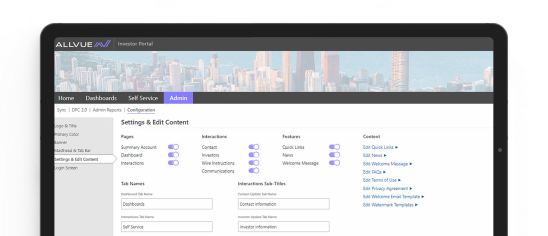
By: Yuriy Shterk
Chief Product Officer
March 29, 2021
With competition fierce for deals and fundraising, GPs have always been sensitive to the fact that success requires being able to process vast amounts of data and make sense of that data, turning it into valuable, actionable information.
As investors increase allocations to private debt, efficient access to information is becoming a differentiator for GPs wishing to demonstrate performance and risk management. Over the past year, the pandemic has highlighted the data issue as GPs have sought a more efficient way to access, aggregate, and standardize data to optimize its value in a fast-moving market. Investors receive multiple types of data from multiple sources including investees, industry and third-party sources, news and analytics, etc., which needs to be merged with internal data from their back office, deal team, investment team, and others to present fully accurate, actionable information to their investors and internal stakeholders.
But without a holistic approach to collecting, processing, aggregating, analyzing, and reporting to stakeholders the enormous amounts of information they possess, the data GPs collect cannot be used properly.
What’s more, as GPs expand into multi-asset class and multi-currency investments, utilizing spreadsheets or stringing together multiple single-point solutions opens them up to a reliance on manual processes, which in turn can lead to data loss, errors, and an increased allocation of resources to administrative tasks. To avoid these pitfalls, GPs need to examine each step of their data process to understand how they can aggregate and utilize data through a holistic approach.
Five steps in the data journey
Each step in the data journey is critical to its successful utilization, and GPs are faced with multiple challenges in realizing their vision of a holistic approach. Several issues stand out as GPs work to make sense of their data:
- GPs need a lot of data to make decisions, but it comes in different formats and forms and requires reconciliation to be useful
- Data originates from different sources—both internally and externally, and GPs must find a way to normalize and organize it
- Data should be normalized and stored in a central location so various people within the GP’s business can access it quickly and easily
- Data visualization, through private equity reporting and analytics, helps GPs understand the significance of their data
- GPs require a dependable way to disseminate information to investors and other stakeholders
GPs need a lot of data to make better business decisions
The initial hurdle for GPs comes with identifying what data they have access to, as they require copious amounts of data to make informed business decisions quickly. The data they receive is typically comprised of numerous forms and formats, each one unique depending upon its origin. And with data across a wide variety of asset classes – both debt and equity, as well as private and public data – GPs need to know what types of data they have access to in order to gather, reconcile, and convert it into actionable information.
For investments in the public markets, data is easier to come by. Benchmarks such as the S&P 500, and financial and valuation ratios can be employed by fund managers and investors to evaluate their holdings, but no such standards exist for alternative asset classes. For private markets, there are Public Market Equivalent (PME) methodologies such as Long-Nickels or Kaplan Schoar that can be used to compare performance to public indexes, but to effectively utilize these methods, GPs must have control of their data from collection through to reporting.
GPs need to organize disparate data from multiple sources
GPs regularly consume and hold data from multiple internal and external sources. Internally, this data may originate with the deal team, the IR team, the fundraising team, etc., while externally, GPs gather data from partners, investees, third-party vendors, and data partners such as trustees and agents, depending on where they are investing. Each entity possesses unique, specific data streams for different use cases that it uses to perform its business, which cannot easily be reconciled with data streams from other sources. This results in a lot of disparate data, underscoring why it’s important for GPs to know where their data originates from.
For example, GPs with portfolios that hold both lightly-regulated private market investments as well as highly-regulated public market investments need to be able to judge risk and exposure across asset classes and industries in order to make swift decisions about their portfolios. And with GPs delving further into multiple alternative assets such as private equity, venture capital, loans, real estate, and CLOs, the need for the identification of data origins will only become more pressing.
Normalizing and storing data in one central location provides quick access
GPs have long faced the quandary of how to unite disparate types of data, not only for internal processes such as workflow automation, but also for the purpose of providing reporting — both bespoke and standardized — to internal stakeholders such as the deal team, along with LPs.
With data from different sources stored in multiple single point solutions, GPs are hampered in their ability to bring all that data together in order to make sense of it. Typically, there are three to five data sources that need to be normalized for GP operations; the question is, how to do this in a quick and efficient manner? One solution is to build a proprietary system or platform internally, but this requires hiring a team of IT professionals to maintain it, as well as the capital to upgrade the system regularly.
While this may be workable in the short run, it eventually results in taking GPs away from their core competencies and requires added layers of administrative and technology resources that they may wish to deploy elsewhere. Instead, a centralized data repository from a dependable technology-forward provider can consolidate data from all sources, allowing GPs to obtain a more complete picture of their data at a glance.
Data visualization—putting the data to work
A centralized data repository, or data warehouse, aggregates data from multiple systems and sources to facilitate reporting and data analysis by front-to-back- office teams. Once GPs have identified, normalized, and consolidated their data in this single instance, the question becomes how to reconcile and analyze that data across disparate asset classes for easier comparison, to ensure greater visibility into portfolio exposures and risks.
Data visualization can help GPs quickly analyze and identify trends in the large amounts of data they consume, revealing opportunities to improve fund performance, single out financial performance issues, and spot trends across fundraising, deal pipeline, or Investee KPIs. Further, technology solutions that provide customized dashboards and automated workflows increase a GP’s ability to turn data into information that can be shared both internally and externally.
Once GPs are able to visualize the data, they need to understand what the data is trying to tell them via reporting and analytics tools. Using visualization tools that are part of a single-solution business intelligence system to interpret data will give GPs a powerful way to analyze disparate data sets and turn them into usable information. This information can then be shared amongst internal stakeholders such as the deal team and the C-level suite, so they can better gauge the efficacy of their investment decisions across the business and their portfolio.
Communicating information to stakeholders
Lastly, GPs need to solve the communication dilemma across their range of stakeholders. While LPs have always wanted more information from their GPs, the pandemic has brought into sharp focus the need to access a wide range of portfolio and fund data across asset classes to produce consolidated reports for both internal stakeholders and investors.
Generating reports, both standard and bespoke, to communicate these insights is crucial, especially in times of market disruption. What’s more, a solution that makes it easy to build reports is what’s needed, as most GPs don’t have the technical resources or experience when it comes to the data modeling required for reporting. Automated, customized reporting and on-demand reporting for LPs through an investor portal provides easy access to the most up-to-date information. By utilizing an all-in-one solution that includes supplemental fund-level data and self-service reporting, GPs can supply the granular information their investors need, when they need it, without having to increase the amount of manual work they do or add extra staff to the endeavor.
Putting it all together
GPs require an end-to-end solution that lets them manage, aggregate, analyze, and visualize data, as well as one that can help them automate processes, reduce risk, and better serve their investors by providing them with quick and easy access to information via standard and bespoke reporting. A solution that aggregates data in a single instance, automates manual processes, provides business insight, and gives investors on-demand, self-service reporting will also help GPs monitor exposures across their portfolios and mitigate business risk.
Allvue’s fully-integrated solution for GPs increases operational efficiency, improves accuracy, and provides a superior investor experience. From fundraising through to investment, teams are connected via interactive workflows that effortlessly support the gathering, approving, and distribution of data and reports. With tools to visualize and report data to satisfy the needs of both internal deal teams and LP investors, reporting is simple. And multi-asset class coverage capabilities — from Private Equity and Venture Capital, to Loans, Real Estate, and CLOs — let GPs track all of their alternative investments, reconciling disparate data quickly and easily. With Allvue’s scalable solution, GPs can grow their company and take their business to the next level.
More About The Author

Yuriy Shterk
Chief Product Officer
Yuriy has 20+ experience working in different functions for technology solution providers in Capital Markets. The Chief Product Officer of Allvue Systems has most recently worked as Head of Product Management at Fidessa Inc and managed the build out of its derivatives trading OEMS for global financial institutions as well as the execution and analytical tools for global FCMs. Prior to that, he oversaw product development and product strategy at CQG Inc. Yuriy holds a Bachelor of Science from the University of Colorado in Computer Science and a Bachelor of Science from Tashkent Technical University in Computer Engineering.


